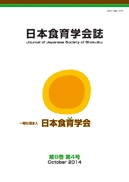
- Issue 4 Pages 157-
- Issue 3 Pages 121-
- Issue 2 Pages 71-
- Issue 1 Pages 15-
- |<
- <
- 1
- >
- >|
-
Nahoko Hosoi, Tomomi Murakami, Masanori Ohta2022 Volume 16 Issue 1 Pages 15-28
Published: January 25, 2022
Released on J-STAGE: March 16, 2022
JOURNAL FREE ACCESSThis study aimed to investigate the effect of eating speed during elementary and junior high school on body size at 20 years of age. We selected men and women aged 20-49 years through an internet survey. The survey comprised the participants’ current height, weight, and eating speed; weight at 20 years of age; body size during elementary and junior high school; presence or absence of food education classes; and eating speed during elementary and junior high school. The results indicated a relationship between eating speed during elementary and junior high school and body mass index (BMI) at 20 years of age. It was found that the faster the eating speed during elementary and junior high school, the higher the BMI at 20 years of age for both men and women (p for trend: all < 0.01). Moreover, these results remained unchanged even after excluding those who were obese during elementary or junior high school. Furthermore, the food education classes during elementary and junior high school caused a significant decrease in the eating speed only in women. In conclusion, our results indicated that a fast-eating speed during elementary and junior high school was associated with a high BMI at 20 years of age, and eating speed in women was affected by food education.
View full abstractDownload PDF (1973K)
-
Relationship between Relative Poverty, Socioeconomic Status, Diet, and Living Conditions in StudentsIkuyo Henmi, Rumi Kimura, Sakae Nishimura, Fumie Miki, Hiroyuki Tanaka ...2022 Volume 16 Issue 1 Pages 29-41
Published: January 25, 2022
Released on J-STAGE: March 16, 2022
JOURNAL FREE ACCESSThe study aimed to clarify the relationship between relative poverty, socioeconomic status, diet, and living conditions in university students. A total of 349 students living in five prefectures, mainly in western Japan, were included in the analysis. About half of the students either did not answer or did not want to answer questions regarding their household income. The students were categorized into three groups for analysis: low-income (below the poverty line), high-income (above the poverty line), and no response or refusal to answer groups. Additionally, binomial logistic regression analysis was performed, adjusting for sex, age, region of residence, and type of residence. Compared to the students in the high-income group, those in the low-income group were more often “refraining from or not able to obtain food due to economic reasons,” consumed “small fish” and “vegetables” less frequently and were more likely to look at their phones during meals. Therefore, our study suggested the impact of relative poverty and its effects on the diet and habits of students.
View full abstractDownload PDF (3469K)
- |<
- <
- 1
- >
- >|